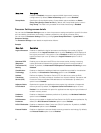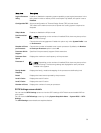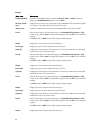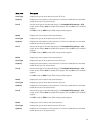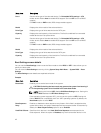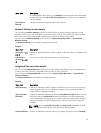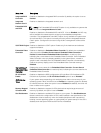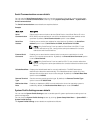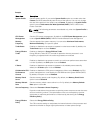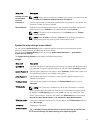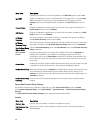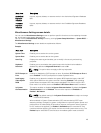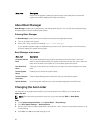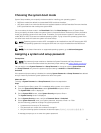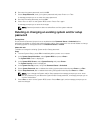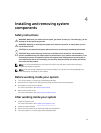
Example
Menu Item Description
System Profile Sets the system profile. If you set the System Profile option to a mode other than
Custom, the BIOS automatically sets the rest of the options. You can only change
the rest of the options if the mode is set to Custom. By default, the System Profile
option is set to Performance Per Watt Optimized (DAPC). DAPC is Dell Active
Power Controller.
NOTE: The following parameters are available only when the System Profile is
set to Custom.
CPU Power
Management
Sets the CPU power management. By default, the CPU Power Management option
is set to System DBPM (DAPC). DBPM is Demand-Based Power Management.
Memory
Frequency
Sets the speed of the system memory. You can select Maximum Performance,
Maximum Reliability, or a specific speed.
Turbo Boost Enables or disables the processor to operate in turbo boost mode. By default, the
Turbo Boost option is set to Enabled.
Energy Efficient
Turbo
Enables or disables the Energy Efficient Turbo.
Energy Efficient Turbo (EET) is a mode of operation where a processor’s core
frequency is adjusted within the turbo range based on workload.
C1E Enables or disables the processor to switch to a minimum performance state when
it is idle. By default, the C1E option is set to Enabled.
C States Enables or disables the processor to operate in all available power states. By
default, the C States option is set to Enabled.
Collaborative CPU
Performance
Control
Enables or disables the CPU power management. When set to Enabled, the CPU
power management is controlled by the OS DBPM and the System DBPM (DAPC).
By default, the option is set to Disabled.
Memory Patrol
Scrub
Sets the memory patrol scrub frequency. By default, the Memory Patrol Scrub
option is set to Standard.
Memory Refresh
Rate
Sets the memory refresh rate to either 1x or 2x. By default, the Memory Refresh
Rate option is set to 1x.
Uncore Frequency Selects the Processor Uncore Frequency.
Dynamic mode allows the processor to optimize power resources across the cores
and uncore during runtime. The optimization of the uncore frequency to either
save power or optimize performance is influenced by the setting of the Energy
Efficiency Policy.
Energy Efficient
Policy
Selects the Energy Efficient Policy.
The CPU uses the setting to manipulate the internal behavior of the processor and
determines whether to target higher performance or better power savings.
46



